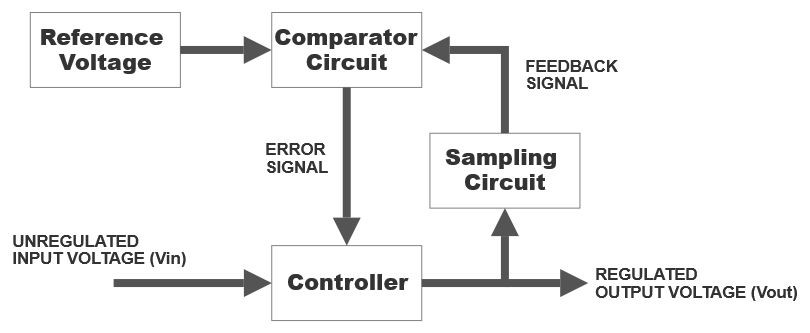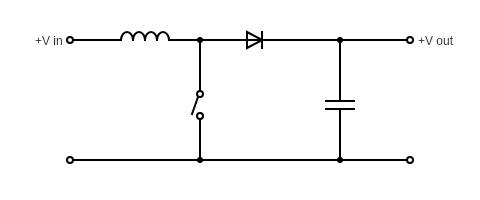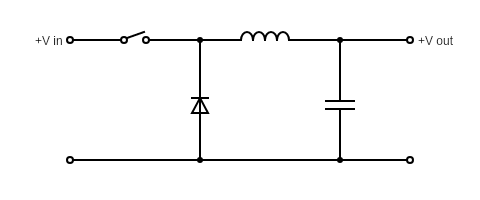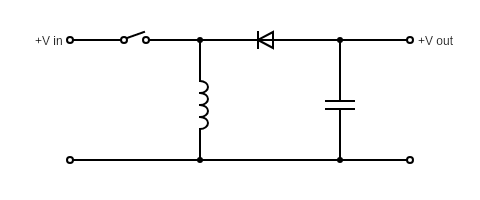How Voltage Regulators Work – Step by Step Explanation
What is a Voltage Regulator
A voltage regulator is an electrical device whose sole purpose is to maintain a constant output voltage. It provides the desired output voltage regardless of any change in the input voltage or load conditions. Electronic circuits are dependent on voltage regulators since they require a stable voltage supply to avoid damage.
How does it work?
The voltage regulator uses the principle of a feedback control system. It relies upon negative feedback control loops.

As you can see, a reference voltage signal is provided to the comparator circuit along with the feedback signal from the controller. The comparator circuit compares both values and sends the error signal to the controller. The controller regulates the output voltage using the error signal from the comparator.
Types of Voltage Regulators
Throughout the world, voltage regulators are the most common electrical component in any machine or device. There are two fundamental types of voltage regulators:
Linear Regulators
A linear voltage regulator works like a voltage divider. The resistance of the linear regulator varies with the connected load and input voltage. Therefore, it is able to supply a constant voltage signal.
Advantages and Disadvantages
Linear regulators have a lot of advantages, for example, they provide a low ripple voltage which means less fluctuation in the output voltage signal. It has a fast response time. Moreover, it has low electromagnetic interference and less noise.
The efficiency of the linear voltage regulator is low and it dissipates a lot of heat so a heat sink is needed. It also requires more space. One of the main disadvantages is that the output voltage cannot exceed the input voltage.
Types of Linear Voltage Regulators
- Shunt
- Series
Shunt Regulators
A shunt regulator is used for low-powered circuits. It works by directing the current away from the load and sending it into the ground. It provides a path from the input voltage to a variable resistor which is connected to the ground. It has a very low efficiency but since the wasted current has a very low value, it is neglected.
Applications
- Used to absorb current (Sink circuits)
- Amplifiers
- Voltage power supplies
- Electronic circuits that need a precise voltage reference
Series Regulators
The operation of a series voltage regulator is dependent upon the variable component which is connected with the load. When the resistance of the variable component is changed, the voltage drop across the component also changes. Using this technique, the voltage across the load remains the same.
One of the main advantages is that since the variable component and the load are connected in series, the current flowing through them is the same. Thus, the load effectively uses the current. Which makes it more efficient than a shunt regulator.
Switching Voltage Regulators
Switching voltage regulators consist of a series device that is repeatedly switched on and off at a high frequency. The duty cycle is used to control the amount of charge supplied to the load. The duty cycle is controlled by a feedback system that is very similar to the one in the linear regulator. Switching regulators have a high efficiency because the load is either on or off which means it dissipates no energy when it is off.
The switching regulator is superior to the linear regulator when it comes to the output voltage. Because it can supply an output voltage signal which can be greater than the input voltage. Furthermore, it can even generate an opposite polarity voltage signal.
Types of Switching Regulators
- Step Up (Boost)
- Step Down (Buck)
- Step Up/Step Down (Boost/Buck)
Step Up Regulators
Also known as a boost regulator, Step up regulators generate a higher output voltage signal by increasing the input voltage signal. This type of regulator is most commonly used to power multiple LEDs.

Step Down Regulators
Step Down regulators are also called buck regulators. They supply a lower regulated output voltage signal from a higher unregulated input voltage signal.

Step Up/Step Down Regulators
The purpose of this regulator is to increase, decrease or invert the voltage signal. Moreover, it is also called a voltage inverter circuit. Opposite polarity is achieved by the forward and reverse biasing action of the diode. During the off-time, the circuit charges the capacitor and when the capacitor is fully charged, it supplies the opposite polarity output. The efficiency of this type of voltage regulator is very high.

Transistor Voltage Regulators
Zener diodes have a mode due to which it can act as a voltage regulator. This mode is known as the reverse breakdown voltage operation. During this mode, the Zener diode maintains constant output DC voltage signal while the AC ripple voltage signal is completely blocked.

Applications of Voltage Regulators
There are many applications of voltage regulators. One of the most common examples is the mobile charger. The adapter is supplied with an AC signal. However, the output voltage signal is a regulated DC signal.
Every power supply in the world uses a voltage regulator to provide the desired output voltage. Computers, televisions, laptops and all sorts of devices are powered using this concept.
Small electronic circuits rely on regulators to operate. Even the slightest fluctuation in voltage signal can damage the components of a circuit such as ICs.
When it comes to power generation systems, voltage regulators play an essential part in its operation. A solar power plant generates electricity based on the intensity of sunlight. It needs a regulator to ensure a regulated constant output signal.
Shop Voltage Regulators
Learn and read more from our Blog

